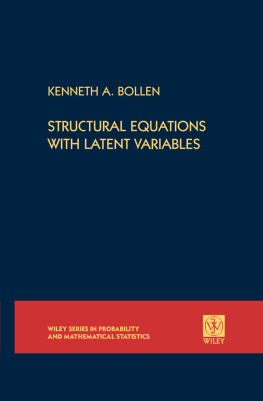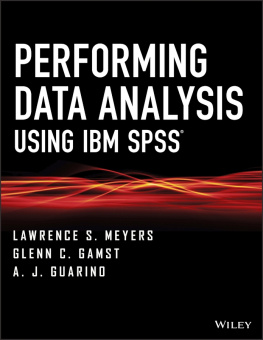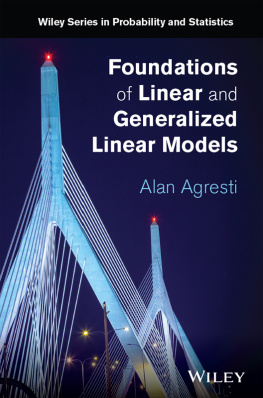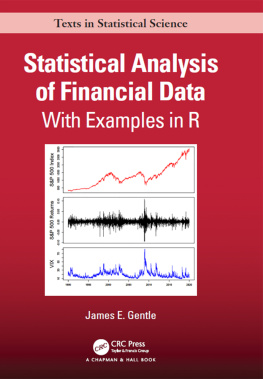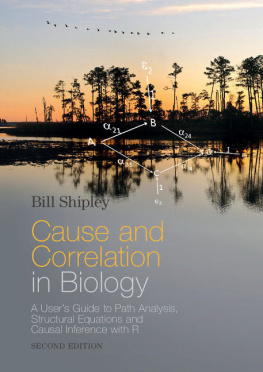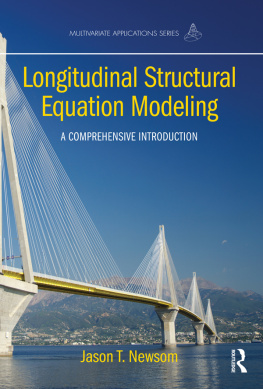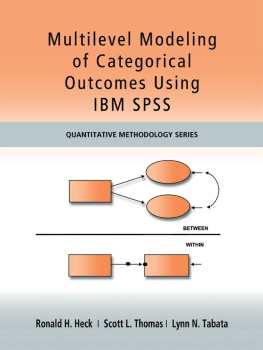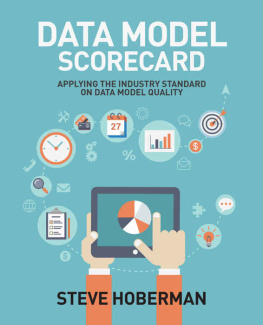To Barbara and to my parents
Copyright 1989 by John Wiley & Sons, Inc.
All rights reserved. Published simultaneously in Canada.
Reproduction or translation of any part of this work beyond that permitted by Section 107 or 108 of the 1976 United States Copyright Act without the permission of the copyright owner is unlawful. Requests for permission or further information should be addressed to the Permissions Department, John Wiley & Sons, Inc.
Library of Congress Cataloging in Publication Data:
Bollen, Kenneth A.
Structural equations with latent variables/Kenneth A. Bollen.
p. cm. (Wiley series in probability and mathematical statistics. Applied probability and statistics section, ISSN 0271-6356)
Wiley-Interscience publication.
Bibliography: p.
Includes index.
1. Social sciencesStatistical methods. 2. Latent variables.
I. Title. II. Series.
HA29.B732 1989
300'.29dc 19
88-27272
ISBN 0-471-01171-1
CIP
Preface
Within the past decade the vocabulary of quantitative research in the social sciences has changed. Terms such as LISREL, covariance structures, latent variables, multiple indicators, and path models are commonplace. The structural equation models that lie behind these terms are a powerful generalization of earlier statistical approaches. They are changing researchers perspectives on statistical modeling and building bridges between the way social scientists think substantively and the way they analyze data.
We can view these models in several ways. They are regression equations with less restrictive assumptions that allow measurement error in the explanatory as well as the dependent variables. They consist of factor analyses that permit direct and indirect effects between factors. They routinely include multiple indicators and latent variables. In brief, these models encompass and extend regression, econometric, and factor analysis procedures.
The book provides a comprehensive introduction to the general structural equation system, commonly known as the LISREL model. One purpose of the book is to demonstrate the generality of this model. Rather than treating path analysis, recursive and nonrecursive models, classical econometrics, and confirmatory factor analysis as distinct and unique, I treat them as special cases of a common model. Another goal of the book is to emphasize the application of these techniques. Empirical examples appear throughout. To gain practice with the procedures, I encourage the reader to reestimate the examples, and then to devise and estimate new models. Several chapters contain some of the LISREL or EQS programs I used to obtain the results for the empirical examples. I have kept the examples as realistic as possible. This means that some of the initial specifications do not fit well. Through my experiences with students, colleagues, and in my own work, I frequently have found that the beginning model does not adequately describe the data. Respecification is often necessary. I note the difficulties this creates in proper interpretations of significance tests and the added importance of replication.
A final purpose is to emphasize the crucial role played by substantive expertise in most stages of the modeling process. Structural equation models are not very helpful if you have little idea about the subject matter. To begin the fitting process, the analysts must draw upon their knowledge to construct a multiequation system that specifies the relations between all latent variables, disturbances, and indicators. Furthermore they must turn to substantive information when respecifying models and when evaluating the final model. Empirical results can reveal that initial ideas are in error or they can suggest ways to modify a model, but they are given meaning only within the context of a substantively informed model.
Structural equation models can be presented in two ways. One is to start with the general model and then show its specializations to simpler models. The other is to begin with the simpler models and to build toward the general model. I have chosen the latter strategy. I start with the regression/econometric and factor analysis models and present them from the perspective of the general model. This has the advantage of gradually including new material while having types of models with which the reader is somewhat familiar. It also encourages viewing old techniques in a new light and shows the often unrealistic assumptions implicit in standard regression/econometric and factor analyses.
Specifically, I have organized the book as follows. Chapter 2 introduces several methodological tools. I present the model notation, covariances and covariance algebra, and a more detailed account of path analysis. Appendixes A and B at the end of the book provide reviews of matrix algebra and of asymptotic distribution theory. Chapter 3 addresses the issue of causality. Implicitly, the idea of causality pervades much of the structural equation writings. The meaning of causality is subject to much controversy. I raise some of the issues behind the controversy and present a structural equation perspective on the meaning of causality.
The regression/econometric models for observed variables are the subject of Chapter 4. Though many readers have experience with these, the covariance structure viewpoint will be new to many. The consequences of random measurement error in observed variable models is the topic of Chapter 5. The chapter shows why and when we should care about measurement error in observed variables.
Once we recognize that variables are measured with error, we need to consider the relation between the error-free variable and the observed variable. Chapter 6 is an examination of this relation. It introduces procedures for developing measures and explores the concepts of reliability and validity. Chapter 7 is on confirmatory factor analysis, which is used for estimating measurement models such as those in Chapter 6.
Finally, Chapters 8 and 9 provide the general structural equation model with latent variables. Chapter 8 emphasizes the basics, whereas Chapter 9 treats more advanced topics such as arbitrary distribution estimators and the treatment of categorical observed variables.
The main motivation for writing this book arose from my experiences teaching at the Interuniversity Consortium for Political and Social Research (ICPSR) Summer Training Program in Methodology at the University of Michigan (19801988). I could not find a text suitable for graduate students and professionals with training in different disciplines. Nor could I find a comprehensive introduction to these procedures. I have written the book for social scientists, market researchers, applied statisticians, and other analysts who plan to use structural equation or LISREL models. I assume that readers have prior exposure and experience with matrix algebra and regression analysis. A background in factor analysis is helpful but not essential. Jreskog and Srboms (1986) LISREL and Benders (1985) EQS are the two most popular structural equation software packages. I make frequent reference to them, but the ideas of the book extend beyond any specific program.
I have many people to thank for help in preparing this book. The Interuniversity Consortium for Political and Social Research (ICPSR) at the U niversity of Michigan (Ann Arbor) has made it possible for me to teach these techniques for the last nine years in their Summer Program in Quantitative Methods. Bob Hoyer started me there. Hank Heitowit and the staff of ICPSR have continued to make it an ideal teaching environment. A number of the hundreds of graduate students, professors, and other professionals who attended the courses provided general and specific comments to improve the book. Gerhard Arminger (University of Wuppertal), Jan de Leeuw (University of Leiden), Raymond Horton (Lehigh University), Frederick Lorenz (Iowa State University), John Fox (York University), Robert Stine (University of Pennsylvania), Boone Turchi (University of North Carolina), and members of the Statistical and Mathematical Sociology Group at the University of North Carolina provided valuable comments on several of the chapters. Barbara Entwisle Bollen read several drafts of most chapters, and her feedback and ideas are reflected throughout the book. Without her encouragement, I do not know when or if I would h ave completed the book.

